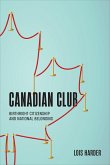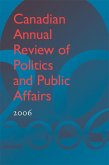- Gebundenes Buch
- Merkliste
- Auf die Merkliste
- Bewerten Bewerten
- Teilen
- Produkt teilen
- Produkterinnerung
- Produkterinnerung
Canadian Public Policy provides the first comprehensive, theoretically informed, empirical evaluation of the development of public policy in Canada.
Andere Kunden interessierten sich auch für
![Canadian Urban Governance in Comparative Perspective Canadian Urban Governance in Comparative Perspective]() Canadian Urban Governance in Comparative Perspective75,99 €
Canadian Urban Governance in Comparative Perspective75,99 €![Canadian Club Canadian Club]() Lois HarderCanadian Club30,99 €
Lois HarderCanadian Club30,99 €![Gender-Based Violence in Canadian Politics in the #Metoo Era Gender-Based Violence in Canadian Politics in the #Metoo Era]() Gender-Based Violence in Canadian Politics in the #Metoo Era93,99 €
Gender-Based Violence in Canadian Politics in the #Metoo Era93,99 €![Faith, Rights, and Choice Faith, Rights, and Choice]() James FarneyFaith, Rights, and Choice30,99 €
James FarneyFaith, Rights, and Choice30,99 €![Canadian Annual Review of Politics and Public Affairs 2006 Canadian Annual Review of Politics and Public Affairs 2006]() David MutimerCanadian Annual Review of Politics and Public Affairs 2006172,99 €
David MutimerCanadian Annual Review of Politics and Public Affairs 2006172,99 €![Canadian Parties in Transition, Fifth Edition Canadian Parties in Transition, Fifth Edition]() Canadian Parties in Transition, Fifth Edition89,99 €
Canadian Parties in Transition, Fifth Edition89,99 €![Winning and Keeping Power in Canadian Politics Winning and Keeping Power in Canadian Politics]() Jason RoyWinning and Keeping Power in Canadian Politics70,99 €
Jason RoyWinning and Keeping Power in Canadian Politics70,99 €-
-
-
Canadian Public Policy provides the first comprehensive, theoretically informed, empirical evaluation of the development of public policy in Canada.
Hinweis: Dieser Artikel kann nur an eine deutsche Lieferadresse ausgeliefert werden.
Hinweis: Dieser Artikel kann nur an eine deutsche Lieferadresse ausgeliefert werden.
Produktdetails
- Produktdetails
- Verlag: University of Toronto Press
- Seitenzahl: 240
- Erscheinungstermin: 16. Juli 2013
- Englisch
- Abmessung: 231mm x 152mm x 20mm
- Gewicht: 486g
- ISBN-13: 9781442644069
- ISBN-10: 1442644060
- Artikelnr.: 37231528
- Herstellerkennzeichnung
- Libri GmbH
- Europaallee 1
- 36244 Bad Hersfeld
- gpsr@libri.de
- Verlag: University of Toronto Press
- Seitenzahl: 240
- Erscheinungstermin: 16. Juli 2013
- Englisch
- Abmessung: 231mm x 152mm x 20mm
- Gewicht: 486g
- ISBN-13: 9781442644069
- ISBN-10: 1442644060
- Artikelnr.: 37231528
- Herstellerkennzeichnung
- Libri GmbH
- Europaallee 1
- 36244 Bad Hersfeld
- gpsr@libri.de
Michael Howlett is Burnaby Mountain Chair in the Department of Political Science at Simon Fraser University and Yong Pung How Chair Professor in the Lee Kuan Yew School of Public Policy at the National University of Singapore.
Table of Figures
Table of Tables
Acknowledgements
Part I – Introduction
Chapter 1. – Introduction
1. General Approach
2. Contents: Introduction: Policy Development as Decision-Making Process
3. Historical Overview: The Ir/Rationality of Policy Development
4. Problems with Existing Models: False Dichotomies and Corrective
Syntheses
5. Elements of a Policy Style
6. Conclusion: Policy Development as Policy Style
Part II - The Policy Process in Canada
Chapter 2. - Agenda-Setting - Predictable and Unpredictable Policy Windows:
Institutional and Exogenous Correlates of Canadian Federal Agenda-Setting
1. Policy Windows and Policy Theory
2. Analytical Components of the Policy Streams Model
3. Policy Windows in Canada: Empirical Evidence
4. Conclusion
5. Appendix 1: Data Sources
6. Appendix 2: Caseplots of Issues
7. Appendix 3: Caseplots of Institutional Events
8. Appendix 4: Caseplots of Objective Correlates
Chapter 3. - Policy Formulation: Do Networks Matter? Linking Policy Network
Structure to Policy Outcomes: Evidence from Four Canadian Policy Sectors
1990-2000
1. Introduction: Metaphors and Models in Policy Network Analysis
2. The Link between Subsystem Structure and Policy Change in Policy Network
Analysis
3. Testing the Impact of Subsystem Structure on Policy Outcomes: The
Elements of an Operational Model of Policy
4. Operationalizing Policy Subsystems
5. Linking Subsystem Configurations to Policy Change
6. Testing the Model: Empirical Evidence from Four Canadian Cases 1990-2000
7. Conclusion
8. Appendix: Data Sources and Summaries
Chapter 4. - Decision-Making - Analyzing Multi-Actor, Multi-Round Public
Policy Decision-Making Processes in Government: Findings from Five Canadian
Cases
1. Introduction
2. The Concept of a Public Policy Decision-Making Style
3. Method and Case Selection
4. Analysis
a. Evaluating Hypothesis 1
b. Evaluating Hypothesis 2
c. Evaluating Hypothesis 3
5. Conclusion: Findings and Future Research Directions
6. Appendix A
7. Appendix B - Description of Key Legislative Changes By Issue Area
8. Appendix C - Governmental and Non-governmental Actor Activity by Issue
and Year
9. Appendix D - Types of Actor Activity by Rounds
Chapter 5. - Policy Implementation: Managing the "Hollow State": Procedural
Policy Instruments and Modern Governance
1. Studying Policy Instruments
2. Analysing Procedural Policy Instruments
3. The Rationale for Procedural Instrument Choice
4. Conclusion: Policy Instruments for Modern Governance
Chapter 6. - Policy Evaluation – Policy Advice in Multi-Level Governance
Systems: Sub-National Policy Analysts and Analysis
1. Introduction: The Supply and Demand for Policy Analysis in Government'
2. The Sub-National Case: Provincial Policy Analysts in Canada
3. Methods
4. The Profile of Provincial Policy Analysts
5. Conclusion
Part III – Conclusion
Chapter 7. - Conclusion - Policy Analytical Capacity and Evidence-based
Policy-making: Lessons from Canada
1. Evidence-based Policy-making as an Effort to Avoid Policy Failures and
Enhance the Potential for Policy Success Through Policy Learning
2. Types of Policy Failures and the Role Played by Evidence Therein
3. Defining Policy Analytical Capacity
4. Assessing Policy Analytical Capacity in Practice
5. Policy Analytical Capacity in Canada
6. Conclusion
Endnotes
References
Table of Tables
Acknowledgements
Part I – Introduction
Chapter 1. – Introduction
1. General Approach
2. Contents: Introduction: Policy Development as Decision-Making Process
3. Historical Overview: The Ir/Rationality of Policy Development
4. Problems with Existing Models: False Dichotomies and Corrective
Syntheses
5. Elements of a Policy Style
6. Conclusion: Policy Development as Policy Style
Part II - The Policy Process in Canada
Chapter 2. - Agenda-Setting - Predictable and Unpredictable Policy Windows:
Institutional and Exogenous Correlates of Canadian Federal Agenda-Setting
1. Policy Windows and Policy Theory
2. Analytical Components of the Policy Streams Model
3. Policy Windows in Canada: Empirical Evidence
4. Conclusion
5. Appendix 1: Data Sources
6. Appendix 2: Caseplots of Issues
7. Appendix 3: Caseplots of Institutional Events
8. Appendix 4: Caseplots of Objective Correlates
Chapter 3. - Policy Formulation: Do Networks Matter? Linking Policy Network
Structure to Policy Outcomes: Evidence from Four Canadian Policy Sectors
1990-2000
1. Introduction: Metaphors and Models in Policy Network Analysis
2. The Link between Subsystem Structure and Policy Change in Policy Network
Analysis
3. Testing the Impact of Subsystem Structure on Policy Outcomes: The
Elements of an Operational Model of Policy
4. Operationalizing Policy Subsystems
5. Linking Subsystem Configurations to Policy Change
6. Testing the Model: Empirical Evidence from Four Canadian Cases 1990-2000
7. Conclusion
8. Appendix: Data Sources and Summaries
Chapter 4. - Decision-Making - Analyzing Multi-Actor, Multi-Round Public
Policy Decision-Making Processes in Government: Findings from Five Canadian
Cases
1. Introduction
2. The Concept of a Public Policy Decision-Making Style
3. Method and Case Selection
4. Analysis
a. Evaluating Hypothesis 1
b. Evaluating Hypothesis 2
c. Evaluating Hypothesis 3
5. Conclusion: Findings and Future Research Directions
6. Appendix A
7. Appendix B - Description of Key Legislative Changes By Issue Area
8. Appendix C - Governmental and Non-governmental Actor Activity by Issue
and Year
9. Appendix D - Types of Actor Activity by Rounds
Chapter 5. - Policy Implementation: Managing the "Hollow State": Procedural
Policy Instruments and Modern Governance
1. Studying Policy Instruments
2. Analysing Procedural Policy Instruments
3. The Rationale for Procedural Instrument Choice
4. Conclusion: Policy Instruments for Modern Governance
Chapter 6. - Policy Evaluation – Policy Advice in Multi-Level Governance
Systems: Sub-National Policy Analysts and Analysis
1. Introduction: The Supply and Demand for Policy Analysis in Government'
2. The Sub-National Case: Provincial Policy Analysts in Canada
3. Methods
4. The Profile of Provincial Policy Analysts
5. Conclusion
Part III – Conclusion
Chapter 7. - Conclusion - Policy Analytical Capacity and Evidence-based
Policy-making: Lessons from Canada
1. Evidence-based Policy-making as an Effort to Avoid Policy Failures and
Enhance the Potential for Policy Success Through Policy Learning
2. Types of Policy Failures and the Role Played by Evidence Therein
3. Defining Policy Analytical Capacity
4. Assessing Policy Analytical Capacity in Practice
5. Policy Analytical Capacity in Canada
6. Conclusion
Endnotes
References
Table of Figures
Table of Tables
Acknowledgements
Part I – Introduction
Chapter 1. – Introduction
1. General Approach
2. Contents: Introduction: Policy Development as Decision-Making Process
3. Historical Overview: The Ir/Rationality of Policy Development
4. Problems with Existing Models: False Dichotomies and Corrective
Syntheses
5. Elements of a Policy Style
6. Conclusion: Policy Development as Policy Style
Part II - The Policy Process in Canada
Chapter 2. - Agenda-Setting - Predictable and Unpredictable Policy Windows:
Institutional and Exogenous Correlates of Canadian Federal Agenda-Setting
1. Policy Windows and Policy Theory
2. Analytical Components of the Policy Streams Model
3. Policy Windows in Canada: Empirical Evidence
4. Conclusion
5. Appendix 1: Data Sources
6. Appendix 2: Caseplots of Issues
7. Appendix 3: Caseplots of Institutional Events
8. Appendix 4: Caseplots of Objective Correlates
Chapter 3. - Policy Formulation: Do Networks Matter? Linking Policy Network
Structure to Policy Outcomes: Evidence from Four Canadian Policy Sectors
1990-2000
1. Introduction: Metaphors and Models in Policy Network Analysis
2. The Link between Subsystem Structure and Policy Change in Policy Network
Analysis
3. Testing the Impact of Subsystem Structure on Policy Outcomes: The
Elements of an Operational Model of Policy
4. Operationalizing Policy Subsystems
5. Linking Subsystem Configurations to Policy Change
6. Testing the Model: Empirical Evidence from Four Canadian Cases 1990-2000
7. Conclusion
8. Appendix: Data Sources and Summaries
Chapter 4. - Decision-Making - Analyzing Multi-Actor, Multi-Round Public
Policy Decision-Making Processes in Government: Findings from Five Canadian
Cases
1. Introduction
2. The Concept of a Public Policy Decision-Making Style
3. Method and Case Selection
4. Analysis
a. Evaluating Hypothesis 1
b. Evaluating Hypothesis 2
c. Evaluating Hypothesis 3
5. Conclusion: Findings and Future Research Directions
6. Appendix A
7. Appendix B - Description of Key Legislative Changes By Issue Area
8. Appendix C - Governmental and Non-governmental Actor Activity by Issue
and Year
9. Appendix D - Types of Actor Activity by Rounds
Chapter 5. - Policy Implementation: Managing the "Hollow State": Procedural
Policy Instruments and Modern Governance
1. Studying Policy Instruments
2. Analysing Procedural Policy Instruments
3. The Rationale for Procedural Instrument Choice
4. Conclusion: Policy Instruments for Modern Governance
Chapter 6. - Policy Evaluation – Policy Advice in Multi-Level Governance
Systems: Sub-National Policy Analysts and Analysis
1. Introduction: The Supply and Demand for Policy Analysis in Government'
2. The Sub-National Case: Provincial Policy Analysts in Canada
3. Methods
4. The Profile of Provincial Policy Analysts
5. Conclusion
Part III – Conclusion
Chapter 7. - Conclusion - Policy Analytical Capacity and Evidence-based
Policy-making: Lessons from Canada
1. Evidence-based Policy-making as an Effort to Avoid Policy Failures and
Enhance the Potential for Policy Success Through Policy Learning
2. Types of Policy Failures and the Role Played by Evidence Therein
3. Defining Policy Analytical Capacity
4. Assessing Policy Analytical Capacity in Practice
5. Policy Analytical Capacity in Canada
6. Conclusion
Endnotes
References
Table of Tables
Acknowledgements
Part I – Introduction
Chapter 1. – Introduction
1. General Approach
2. Contents: Introduction: Policy Development as Decision-Making Process
3. Historical Overview: The Ir/Rationality of Policy Development
4. Problems with Existing Models: False Dichotomies and Corrective
Syntheses
5. Elements of a Policy Style
6. Conclusion: Policy Development as Policy Style
Part II - The Policy Process in Canada
Chapter 2. - Agenda-Setting - Predictable and Unpredictable Policy Windows:
Institutional and Exogenous Correlates of Canadian Federal Agenda-Setting
1. Policy Windows and Policy Theory
2. Analytical Components of the Policy Streams Model
3. Policy Windows in Canada: Empirical Evidence
4. Conclusion
5. Appendix 1: Data Sources
6. Appendix 2: Caseplots of Issues
7. Appendix 3: Caseplots of Institutional Events
8. Appendix 4: Caseplots of Objective Correlates
Chapter 3. - Policy Formulation: Do Networks Matter? Linking Policy Network
Structure to Policy Outcomes: Evidence from Four Canadian Policy Sectors
1990-2000
1. Introduction: Metaphors and Models in Policy Network Analysis
2. The Link between Subsystem Structure and Policy Change in Policy Network
Analysis
3. Testing the Impact of Subsystem Structure on Policy Outcomes: The
Elements of an Operational Model of Policy
4. Operationalizing Policy Subsystems
5. Linking Subsystem Configurations to Policy Change
6. Testing the Model: Empirical Evidence from Four Canadian Cases 1990-2000
7. Conclusion
8. Appendix: Data Sources and Summaries
Chapter 4. - Decision-Making - Analyzing Multi-Actor, Multi-Round Public
Policy Decision-Making Processes in Government: Findings from Five Canadian
Cases
1. Introduction
2. The Concept of a Public Policy Decision-Making Style
3. Method and Case Selection
4. Analysis
a. Evaluating Hypothesis 1
b. Evaluating Hypothesis 2
c. Evaluating Hypothesis 3
5. Conclusion: Findings and Future Research Directions
6. Appendix A
7. Appendix B - Description of Key Legislative Changes By Issue Area
8. Appendix C - Governmental and Non-governmental Actor Activity by Issue
and Year
9. Appendix D - Types of Actor Activity by Rounds
Chapter 5. - Policy Implementation: Managing the "Hollow State": Procedural
Policy Instruments and Modern Governance
1. Studying Policy Instruments
2. Analysing Procedural Policy Instruments
3. The Rationale for Procedural Instrument Choice
4. Conclusion: Policy Instruments for Modern Governance
Chapter 6. - Policy Evaluation – Policy Advice in Multi-Level Governance
Systems: Sub-National Policy Analysts and Analysis
1. Introduction: The Supply and Demand for Policy Analysis in Government'
2. The Sub-National Case: Provincial Policy Analysts in Canada
3. Methods
4. The Profile of Provincial Policy Analysts
5. Conclusion
Part III – Conclusion
Chapter 7. - Conclusion - Policy Analytical Capacity and Evidence-based
Policy-making: Lessons from Canada
1. Evidence-based Policy-making as an Effort to Avoid Policy Failures and
Enhance the Potential for Policy Success Through Policy Learning
2. Types of Policy Failures and the Role Played by Evidence Therein
3. Defining Policy Analytical Capacity
4. Assessing Policy Analytical Capacity in Practice
5. Policy Analytical Capacity in Canada
6. Conclusion
Endnotes
References








